How the World Was
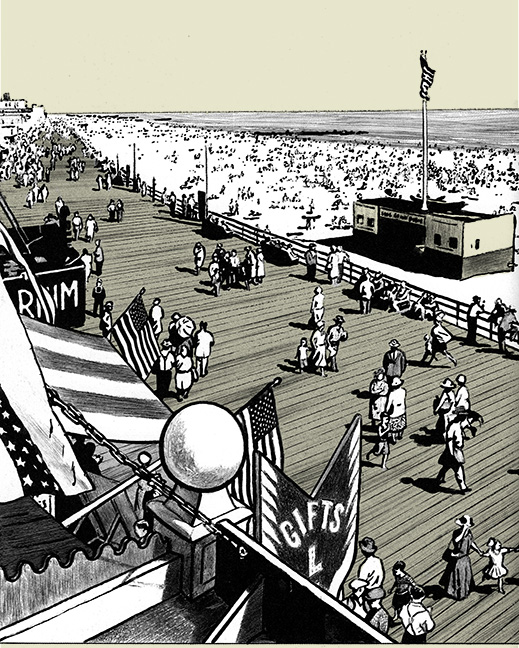
If you've read more than a sturdy handful of my reviews here, you'll likely have gathered that I love to talk about myself. Or perhaps not so much about myself (in terms of ego) but rather about my life, about the things I've experienced, the way things have been. A couple months back, I was trying to describe what I do here at Good Ok Bad and I happened upon the description: memoir-based, low-brow lit-crit. The reason I spend so much time telling stories about who I am and have been is that I believe knowing a critic is essential to understanding how his evaluations will intersect with your own interests, tastes, and values. But also because I find the distinction between now and then absolutely compelling.
I am not old but I'm not young either. I was born in the early '70s and so was part of perhaps the last bulk of free-range children. We roamed neighbourhoods in packs or on our lonesome. We hiked in the local wildernesses on our own or perhaps with a friend, rattlesnake buzzing be damned. Our parents routinely left us in the car to play while doing a half-hour of grocery shopping and no one was at all concerned. The smog in Los Angeles was so thick and constant that skies were perpetually orange and it often hurt a child's lungs to play and on bad days you couldn't see further than a hundred yards. Payphones were essential lifelines. Dialing a phone number containing nines and zeroes might have taken eternities. Not every middle class family owned a computer. People were afraid the D&D players were sacrificing each other in bloody masses in underground tunnels. And the difference between my childhood and my father's immediately-post-WWII childhood is as vast as different between now and 1980. Worlds tilt and shift and change, and if we don't tell these stories, no one will remember to care.
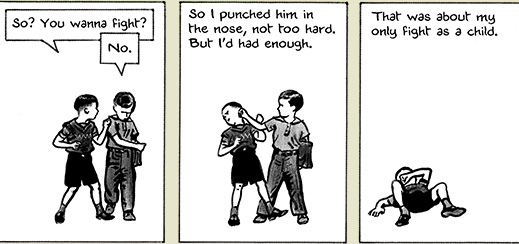 Nice win/loss rating.
Nice win/loss rating.
For this reason, Emanuel Guibert's treatments of Alan Cope's life are essential and fascinating. How the World Was follows on the heels of Alan's War, which largely concerned itself with Cope's place in WWII and its aftermath. How the World Was winds back the clock (another thing growing less and less common) to explore Cope's childhood growing up in Southern California during the Depression. And it's a world-and-a-half away from the Southern California I grew up in.
In both Alan's War and How the World Was, Cope exists as a strange mix of social aloofness and integration. On the one hand he often remains free from the racist, sexist, and homophobic influences around him. He seems less a product of his time and more a product of ours.11It's easy to retain a measure of skepticism that Cope hasn't self-edited his history for our interlocutor, Guibert. Yet on the other hand, he sometimes represents himself as being deeply affected (even on a lifelong psychological level) by particular people and interactions. At one point he relates how a warning from his mother combined with a hornet later that day brought him a lifelong religious aversion to touching his penis—even after he rejects religion outright as a young adult.22Amusingly, even when he was motivated by a strong sense that God disapproved of him making physical contact with his penis, he is clear that he found ways to masturbate without breaking letter of the onanistic law.3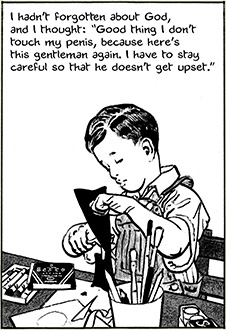 3Trivia! The sin of Onan in the Hebrew scriptures from which we get the term onanism was not actually masturbation. Instead, he was punished for withholding progeny from his brother-in-law's wife by pulling out—perhaps the only time in history that the method actually worked as birth control! In that culture at that time, brothers would take their widowed sister-in-laws into their household in order to continue the hereditary line of the brother. Children born to the widow would be legally considered the children of the deceased brother. Onan, a happy product of the patriarchal zeitgeist, was happy to enjoy sexual consummation with his brother's widow but was careful not to intend actual procreation, thus robbing his brother (and his widow) of the continuation of his line.
3Trivia! The sin of Onan in the Hebrew scriptures from which we get the term onanism was not actually masturbation. Instead, he was punished for withholding progeny from his brother-in-law's wife by pulling out—perhaps the only time in history that the method actually worked as birth control! In that culture at that time, brothers would take their widowed sister-in-laws into their household in order to continue the hereditary line of the brother. Children born to the widow would be legally considered the children of the deceased brother. Onan, a happy product of the patriarchal zeitgeist, was happy to enjoy sexual consummation with his brother's widow but was careful not to intend actual procreation, thus robbing his brother (and his widow) of the continuation of his line.
So Onan's sin, technically speaking, was greed (and perhaps envy of his brother—think "His Face All Red") and its mechanism was Onan "spilling his seed on the ground." From which, of course, we get the aphorism: "Better to spill your seed in the belly of a whore than to spill it on the ground." Because leave it to horny religious people to find a loophole for a law they misinterpreted the whole time.
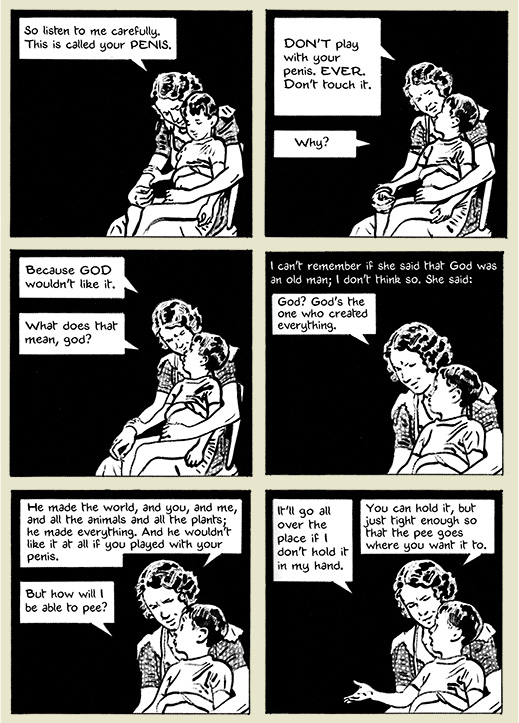 Here mom. Let me explain how peeing works.
Here mom. Let me explain how peeing works.
And on a very brief note, Guibert recreates a number of Southern Californian environments now lost to time save but for the archival efforts of photograph collections and artistic renderings. They portray another kind of world and will be fascinating to students of human history and nature. Scenes from the early 20th century abound. Soda shops, old-town L.A. County, the boardwalk at Santa Monica, simple Depression-era housing. Leave it to a French work to inculcate a nostalgia for a thoroughly American world now lost to us for all time.
How the World Was is less focused than Alan's War. Where the former work had WWII as its principal point of contact with Cope's history (only spreading out in the latter half of the book), the present work culls from the whole of Cope's history in California as well as his family history. The episodes related are all engaging for sure, but the book does suffer a bit from feeling a touch scattered. Focus ranges from Cope as young child to Cope's grandfather in the Civil War to Depression-era living to the introduction of Cope's new stepmother to cousins and aunts and uncles and other extended family. It's almost all dead fascinating, but I can't help but wish the vista was at least slightly more directed.
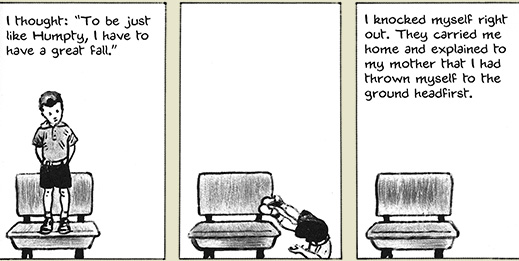 Method acting.
Method acting.
In How the World Was, Guibert sometimes relies on large blocks of text. As with the prior book, Guibert tells the entire story (such as it is) through narrative text that floats outside the action of the book's panels. It worked exceedingly well in Alan's War and is mostly effective here, though there are times when I wished Guibert would have taken a couple extra pages for a particular story, just so that those large blocks of text could be broken up and spread across more panels of art. Because, for whatever reason, a proliferation of words feels too much like an obstacle when encountered in the comics medium. I felt similarly in Joe Sacco's Palestine, and that was one of my chief complaints in the recently reviewed With Only Five Plums.
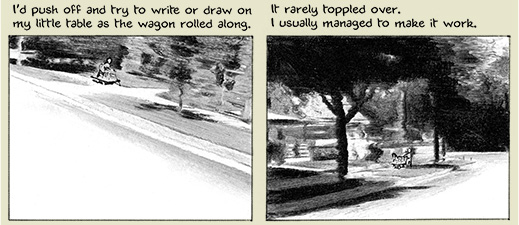 We did awesome/stupid stuff like this all the time growing up.
We did awesome/stupid stuff like this all the time growing up.
Despite these probably petty criticisms, How the World Was is a lovely and very often hilarious work. (There is an episode in which Cope relates how he would set up a writing desk atop a wagon and ride down a hill while calmly writing until having to bail out at ride's end.) Cope's life continues to enthrall and amuse and enlighten. I can only hope Guibert will continue to mine the wealth of Cope's experiences and storytelling prowess. Even if future works are even more scattered, they will continue to provide a wealth of value to readers.
A Note on the Art
I didn't have time to mention it in my review of Alan's War, but Guibert's method for illustration is enchanting. He draws his line art with water and then drops ink in, which then spreads to fill the lines in a various and mottled effect. Here're a couple samples demonstrating the method (completely worth your time!):
Additionally, Guibert uses a number of techniques to fill the greys that texture his work. His methods here remain a mystery to me. Some seem like spongework, but otherwise I am in the dark. All that matters is that his effects are universally lovely.
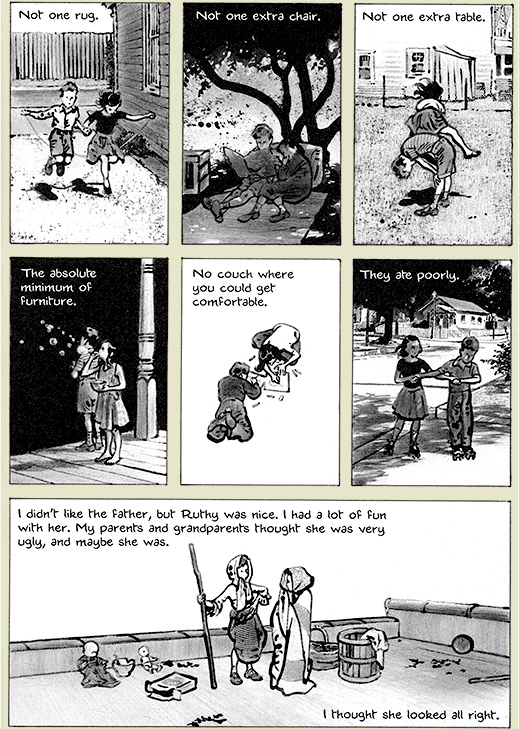 I thought so too.
I thought so too.
Good Ok Bad features reviews of comics, graphic novels, manga, et cetera using a rare and auspicious three-star rating system. Point systems are notoriously fiddly, so here it's been pared down to three simple possibilities:
3 Stars = Good
2 Stars = Ok
1 Star = Bad
I am Seth T. Hahne and these are my reviews.
Browse Reviews By
Other Features
- Best Books of the Year:
- Top 50 of 2024
- Top 50 of 2023
- Top 100 of 2020-22
- Top 75 of 2019
- Top 50 of 2018
- Top 75 of 2017
- Top 75 of 2016
- Top 75 of 2015
- Top 75 of 2014
- Top 35 of 2013
- Top 25 of 2012
- Top 10 of 2011
- Popular Sections:
- All-Time Top 500
- All the Boardgames I've Played
- All the Anime Series I've Seen
- All the Animated Films I've Seen
- Top 75 by Female Creators
- Kids Recommendations
- What I Read: A Reading Log
- Other Features:
- Bookclub Study Guides










